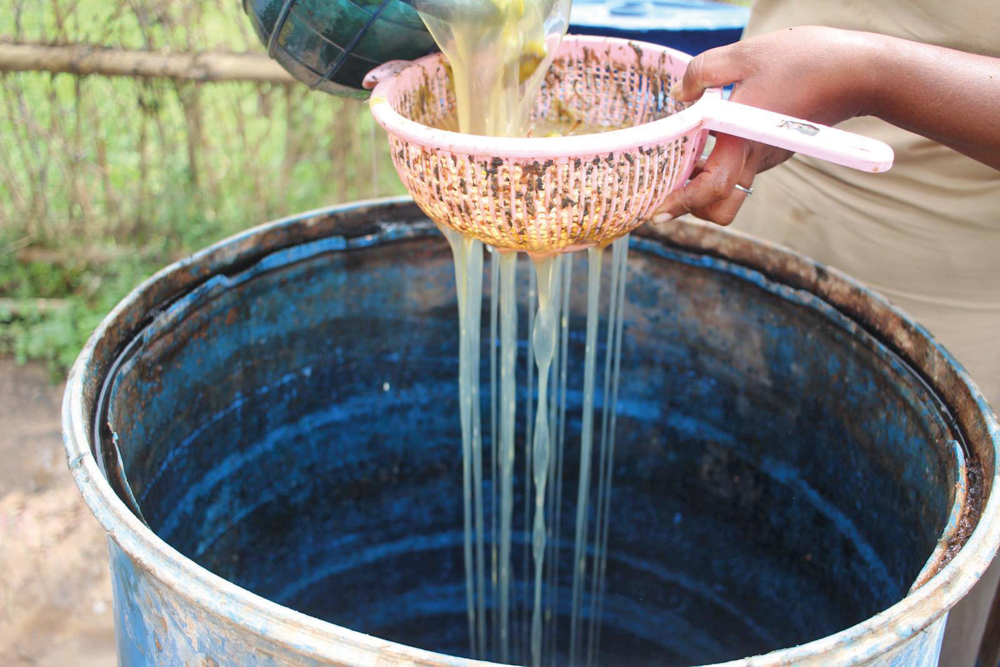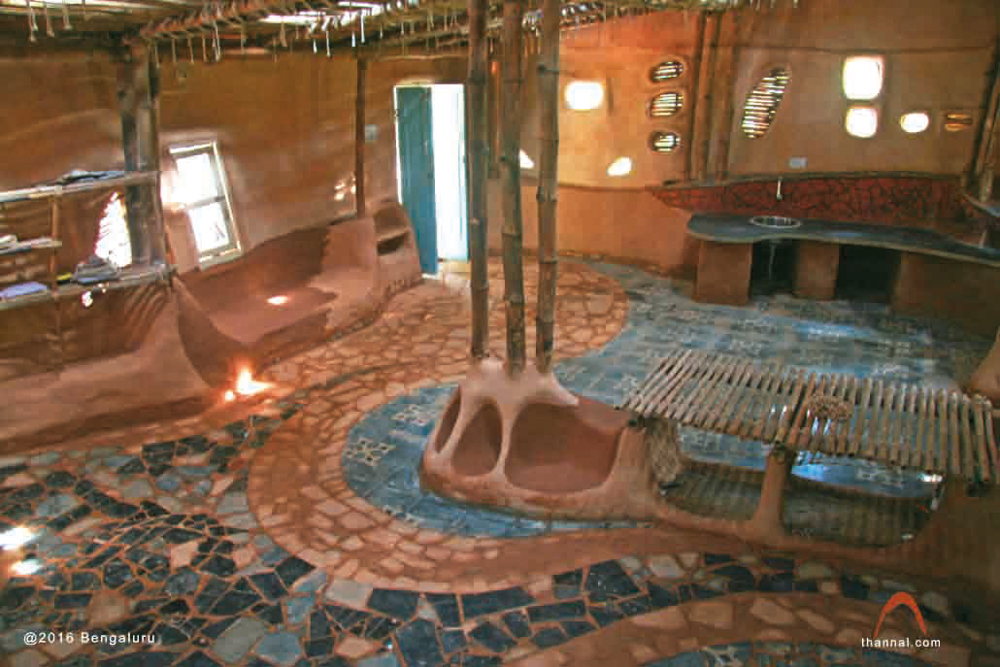courtesy : fwdlife.in
Biju Bhaskar worked in regular architecture for a long duration before quitting it ten years ago. He started Thannal in 2011 with the objective of trying to explore alternative architecture, which consists of green, sustainable, traditional, and vernacular architecture. “We do not compare our works with architecture, but we call it natural building. It’s a term that’s not well-known in the media. The natural building movement is gaining momentum internationally, but is not that progressed in Kerala,” he says. “We have to rethink the subject of mud architecture, which is in practice in Kerala currently, about whether we are doing it through pure sustainable methods,” says Biju, who specializes in mud architecture and operates in the village of Thiruvannamalai in Tamil Nadu.
Building homes was a community-based activity where if you wanted to build your home, your friends, family, neighbors – everyone – came to help you; but today that’s not the case, and one takes huge loans to build their homes. “Kerala is a state that has a large population belonging to the high-income group, so there is a huge potential of using your money to build your home sustainably,” observes Biju. “In the current architectural scenario in Kerala, none of the materials used in building homes is from your native land. Some of the others who proclaim building mud homes are not doing it through pure natural methods, as they are mixing cement with the mud, which lessens the quality of the mud.”
A building’s walls are like the skin on your body – they are porous and have a breathing quality, says Biju. Only the buildings of olden times had such walls and construction; they kept the building naturally cool. “Today’s buildings don’t have such a quality, and instead make the interiors of the building hot. Enormous power is used through air-conditioning to keep it cool.”
Biju says that there are a lot of positive changes happening in India and with the younger generation of architects for the past ten years. “The green movement in agriculture – organic farming, is coming along very well, what with the involvement of renowned people such as the actor, Sreenivasan. A lot of farmers come to meet us.” But at the same time, Biju rues another fact. “What is saddening is that villagers are lured by the urban living styles and moving towards it, discarding their natural means of life. So we are building free homes for them to bring them back to it and make them realise the importance of it.”
Biju takes up only a maximum of two or three projects in a year. Receiving volunteers from all over India, their income is only from the workshops that they hold, claims Biju. A naturally built home of 500-1,000sq ft can be completed in four to five months. The costs, naturally, are always lower than conventionally built structures.
Biju Bhaskar is promoting the concept of
natural building through his venture, Thannal
Architecture does not just entail the construction of a building, but it is the setting up of a philosophy, thought process, values, and ideals. While conventional architectural models may be an inanimate block of concrete and cement that are ‘finished’ at the end of the erection; there are, however, alternate forms of edifices that are more alive through their symbiosis with nature. And Thannal is one such body that works for the assimilation of nature with human dwellings.Biju Bhaskar worked in regular architecture for a long duration before quitting it ten years ago. He started Thannal in 2011 with the objective of trying to explore alternative architecture, which consists of green, sustainable, traditional, and vernacular architecture. “We do not compare our works with architecture, but we call it natural building. It’s a term that’s not well-known in the media. The natural building movement is gaining momentum internationally, but is not that progressed in Kerala,” he says. “We have to rethink the subject of mud architecture, which is in practice in Kerala currently, about whether we are doing it through pure sustainable methods,” says Biju, who specializes in mud architecture and operates in the village of Thiruvannamalai in Tamil Nadu.
Building homes was a community-based activity where if you wanted to build your home, your friends, family, neighbors – everyone – came to help you; but today that’s not the case, and one takes huge loans to build their homes. “Kerala is a state that has a large population belonging to the high-income group, so there is a huge potential of using your money to build your home sustainably,” observes Biju. “In the current architectural scenario in Kerala, none of the materials used in building homes is from your native land. Some of the others who proclaim building mud homes are not doing it through pure natural methods, as they are mixing cement with the mud, which lessens the quality of the mud.”
Accessible to all
The beauty of mud building is that it can be built for anyone, rich or poor; the difference comes only in the finishing, says Biju. “It has been only 90 years since cement came into Kerala, and today we are in a stage where people think that they cannot do without it. But don’t we see buildings that are over a hundred years old that are still going strong – temples, churches, manas, etc.? The concrete buildings of today can last only about 20 years before cracks start developing in it. No concrete building has completed 100 years in Kerala.”
The beauty of mud building is that it can be built for anyone, rich or poor; the difference comes only in the finishing, says Biju. “It has been only 90 years since cement came into Kerala, and today we are in a stage where people think that they cannot do without it. But don’t we see buildings that are over a hundred years old that are still going strong – temples, churches, manas, etc.? The concrete buildings of today can last only about 20 years before cracks start developing in it. No concrete building has completed 100 years in Kerala.”
A building’s walls are like the skin on your body – they are porous and have a breathing quality, says Biju. Only the buildings of olden times had such walls and construction; they kept the building naturally cool. “Today’s buildings don’t have such a quality, and instead make the interiors of the building hot. Enormous power is used through air-conditioning to keep it cool.”
Hand in hand with nature
Another focus area for Thannal is the communion of plants and buildings. “In our research, we have found that plants have a lot of importance in buildings. The bark and sap of plants can be used in various ways in the construction of a building.” And there is no bigger example for this than Biju’s own abode, which is an earthbag home. “It has about 12 varieties of herbal ingredients in it. So the air that passes through the walls is diluted with the essence of these herbs.” Biju points out that cement companies today are one of the major sources of air pollution. The paints used nowadays are also mixed with toxins that are dangerous to people’s health.
Another focus area for Thannal is the communion of plants and buildings. “In our research, we have found that plants have a lot of importance in buildings. The bark and sap of plants can be used in various ways in the construction of a building.” And there is no bigger example for this than Biju’s own abode, which is an earthbag home. “It has about 12 varieties of herbal ingredients in it. So the air that passes through the walls is diluted with the essence of these herbs.” Biju points out that cement companies today are one of the major sources of air pollution. The paints used nowadays are also mixed with toxins that are dangerous to people’s health.
Biju says that there are a lot of positive changes happening in India and with the younger generation of architects for the past ten years. “The green movement in agriculture – organic farming, is coming along very well, what with the involvement of renowned people such as the actor, Sreenivasan. A lot of farmers come to meet us.” But at the same time, Biju rues another fact. “What is saddening is that villagers are lured by the urban living styles and moving towards it, discarding their natural means of life. So we are building free homes for them to bring them back to it and make them realise the importance of it.”
Towards growing more villages
Biju talks about his philosophy at Thannal. “We believe that instead of growing more towns, we should grow more villages because today, the times have changed, and one need not live in an urban scenario for sustenance. Villages and pure natural building should thrive.”
Biju talks about his philosophy at Thannal. “We believe that instead of growing more towns, we should grow more villages because today, the times have changed, and one need not live in an urban scenario for sustenance. Villages and pure natural building should thrive.”
At Thannal, which Biju set up with his wife Sindhu, they give a lot of prominence to research and documentation. With the aim of growing more natural builders, they hold workshops to disperse the awareness. “We have created a hub called Natural Builders of India. Those who pass out have to complete a project in two years that is completely based on natural building. I also bring two-three projects as there are no examples for students in India. And at the end of the project, each student has to bring another student to enroll in it. So according to our calculation, the natural building movement is going to bloom in five years’ time in India. ”
Biju takes up only a maximum of two or three projects in a year. Receiving volunteers from all over India, their income is only from the workshops that they hold, claims Biju. A naturally built home of 500-1,000sq ft can be completed in four to five months. The costs, naturally, are always lower than conventionally built structures.
Thannal works across India and they choose villages after extensive studies. “In our travels, we discovered that all these people who are knowledgeable about natural building in the villages, are all 70-80 years old. We are trying to revive their knowledge, for which, we are living with a master mason every year. We use local people from the particular areas, as that way, there is exchange of information.”
Biju is an avid traveller and a devotee of Ramana Maharshi. Asked why he chose to settle in Thiruvannamalai, Biju says, “It is a place of gurus and a place for self-enquiry. It is one among the Pancha Bhoota Sthalam, and is symbolic of fire. And all gurus have taught that one should build mud houses.”
Biju is an avid traveller and a devotee of Ramana Maharshi. Asked why he chose to settle in Thiruvannamalai, Biju says, “It is a place of gurus and a place for self-enquiry. It is one among the Pancha Bhoota Sthalam, and is symbolic of fire. And all gurus have taught that one should build mud houses.”





































